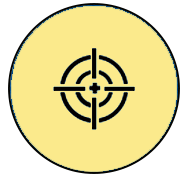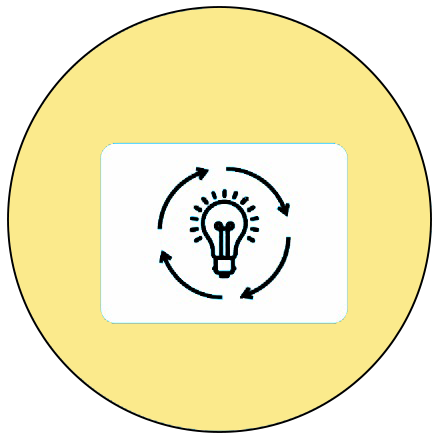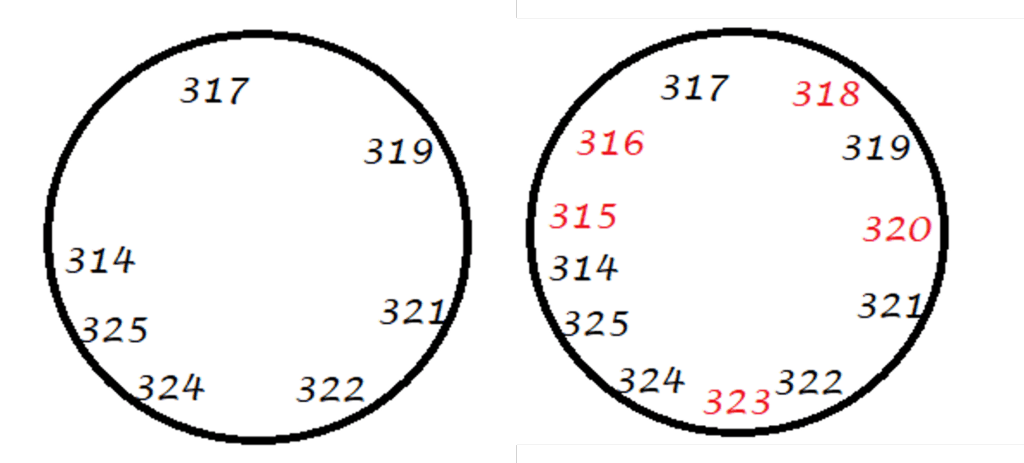
Numbers 100 to 500
Week 3
Learning Outcome
Identifies and writes the number that comes before or after a given number and the number that comes in between two numbers (from 101 to 500).
 Objective
Objective
Children will identify and write the number that comes before and after a given number and the missing number in a sequence using a number line and other multisensory supports.
 Prerequisites
Prerequisites
- Children can write the numeral form and the number name of numbers from 100 to 500.
- The teacher can have a simple check for understanding at the beginning of the lesson by asking the children to write the numbers by showing flashcards.
 Pre-teach Vocabulary
Pre-teach Vocabulary
The children should be familiar with the terms add, plus, equal to, places, after, and before.
Introduction: Exploring Number Sequences with a Number Line
- The teacher could begin by reviewing the numbers that occur after or before any given number between 1 and 99 with the class. Using a large flashcard, the teacher can instruct the children to say the number that comes before the shown number.
- For example, if she/he shows the flashcard with the number 70, she/he will ask them to say the number that comes before 70. Answer: 69
- Similarly, she/he can show the flashcard 87 and ask the children, ‘What comes next to 87?’ Answer: 88
- The teacher will encourage the children to respond for more examples.
Materials required:
- Large classroom number line. (100 to 500, marked or unmarked).
- Individual number strips or mini number lines.
- Flashcards with number sequences. (e.g., ___, 112, 113, or 245, ___, 247).
- Magnetic or Velcro numbers. (For group interaction).
- Whiteboards and markers or number – writing sheets.
- Visual number grids (100s chart).
Teaching Method: I Do—We Do—You Do
I Do (Teacher Models)
- Display a large number line (on the floor or board) from 100 to 120 (start with a small segment).
- Place a marker on 115.
- Ask the children:
- What number comes before 115? (Point left)
- What number comes after 115? (Point right)
- What number is between 114 and 116?
- Say the sequence aloud and show how to use the number line to find the answer.
- Show a missing number card: ___, 119, 120, and solve it aloud: If 119 is here, what comes before it? Let’s go one step left on the number line; it is 118!
- Write the full sequence and say it again slowly, and instruct the children to repeat it.
We Do (Guided Practice)
- Give pairs or groups small number lines or number strips.
- Show a card: 213, ___, 215
- Ask the children:
- Can you point to 213 on your number line?
- Now slide one finger to the right, what number do you land on?
- Groups work together to fill in the missing number using the number line.
- Repeat with a few more examples, calling out different children.
- Can you find the number after 132, team A?
- What comes before 289, team B?
You Do (Independent Practice)
- Distribute the individual worksheets with a mix of
- Number before and number after questions.
- Instruction to fill in the missing number.
- Short number lines to complete.
- Offer choices for task completion.
- Write answers on paper
- Use mini-number lines and magnetic numbers
- Encourage children to explain their thinking:
- How do you know 406 comes after 405?
- Can you tell me what changes when we move from 405 to 406?
Video: Exploring Number Sequences with a Number Line – Coming soon
ISL Video: Exploring Number Sequences with a Number Line – Coming soon
LTM: DIY Flashcards – Coming soon
LTM: Printable Flashcards – Coming soon
LTM: Number Line – Coming soon
Activity 1: Hopscotch Game
Objective: To identify the number that comes before and after a given number.
Importance of the activity for children:
Helps in developing:
- Gross motor skills (Jumping)
- Fine Motor skill (Hand-eye coordination)
- Cognitive skills (Concentration, problem-solving)
- Social skills (Cooperation, waiting for their turn, playing together)
- Language skills (Concepts like before, after, and in between)
- Emotional skills (Builds confidence in numeracy, promotes a sense of achievement that boosts self-esteem, and encourages pride in learning new skills)
Resources required:
Open floor space
Setting for the activity:
The activity can be done indoors or outdoors depending on the space availability.
Type of activity: Individual activity
Preparation of activity:
The teacher will make sure that the boxes are drawn correctly with the required numbers.
Role of the teacher: Demonstrator, observer and facilitator
Procedure:
- The teacher will write down numbers on the floor (e.g., 371 to 380)
- She will ask the child to first identify and then hop to the number that she will say.
For example, when the teacher says, ‘Hop to the number that comes before 379’, the child has to identify that the number is 378 and then hop towards the number.

The same procedure will be continued with other numbers with other children. The game can be continued till all the children get a chance to play.
Observations:
The teacher observes whether children can correctly identify the given number and hop to the appropriate position on the number line. Attention should be paid to accuracy, confidence, and understanding of number sequencing.
Suggested Variations:
- The teacher can incorporate visuals and props to make the lesson more engaging.
Conclusion:
Children would be able to identify the number that comes before and after a given number.
Video: Hopscotch game – Coming soon
ISL Video: Hopscotch game – Coming soon
Activity 2: Fill the Gap
Objective:
To find the missing numbers and stand in the right position.
Importance of the activity for children:
Helps in developing:
- Numerical skills (Number recognition, sequencing, place value)
- Fine motor skills (Picking the flashcards)
- Gross motor skills (Running)
- Cognitive skills (Taking a right position, Memory recall)
- Social skills (Cooperation, waiting for their turn)
- Emotional skills (Builds confidence in numeracy, promotes a sense of achievement that boosts self-esteem, and encourages pride in learning new skills)
Resources required: Flashcards with numbers from 314 to 325
Setting for the activity:
The activity can be done indoors or outdoors depending on the space availability.
Type of activity: Group activity
Preparation of activity:
The teacher will ensure that all required number flashcards (ranging from 100 to 500) are prepared and available before the activity begins.
Role of the teacher: Demonstrator and facilitator
Procedure:
- The teacher selects 7 children from the class. Each child is given a random number card from the sequence 314 to 325. Example cards: 314, 317, 319, 321, 322, 324, and 325.
- Children stand in a circle and hold their number cards out visibly for everyone to see.
- The teacher then selects 5 more children and hands each of them one of the missing number cards from the same range.
- These could be: 315, 316, 318, 320, and 323.
- The new group of children is asked to:
Identify their number, and Stand in the correct position within the circle, filling in the gaps to complete the number sequence.

Observation:
The teacher will observe the children while performing the activity to find if the children:
- Correctly identify the missing number in the sequence.
- Accurately position themselves in the correct place within the circle to complete the number sequence.
- Use peer feedback effectively, listening to suggestions and adjusting their placement as needed.
Suggested variations in the activity:
- The teacher can start the activity by demonstrating with different numbers.
- The difficulty level can be increased by using a larger sequence and introducing more gaps.
Conclusion:
Children will be able to complete number patterns with support and peer interaction.
Video: Fill the gap – Coming soon
ISL Video: Fill the gap – Coming soon
Check list for teacher:
| Activity | Yes | No | Sometimes |
| Children can: | |||
| Identify the number they pick up | |||
| Identify the gap between numbers | |||
| Stand in the right sequence | |||
| Complete the activities in the given time | |||
| Do the activities independently | |||
| Express verbally and through actions, expressions, or gestures | |||
| Enjoy team work, appreciate others, and are willing to learn from others |
Home Activity
Objective:
To choose the number that comes before or after any number through an online fun activity.
Fun activity: Word Wall – Choose the correct number – Coming soon
Adaptations for addressing learner variability: Adaptations and strategies – Coming soon
Cross-Curricular Connection:
Language class:
Number stories can be told or read aloud.
Physical Education class:
‘Run to a number’ game can be played. Flashcards with numbers are spread across the field or hall. The teacher calls out clues like, ‘Find the number that comes before 421’. Children race to find and hold that number.
Assessment
The teacher can give the practice worksheet to children that can be followed by an assessment worksheet.
Practice Worksheet: What comes after/before? – Coming soon
Practice Worksheet: What comes after/before? (Enlarged) – Coming soon
Assessment Worksheet: What comes after/before? – Coming soon
Assessment Worksheet: What comes after/before? (Enlarged) – Coming soon
Teacher Resource Document – Coming Soon
| Source and Attribution of images: All images used in the above Assets and Aids are originally created. |
| This digital material has been developed by the Sri Sathya Sai Vidya Vahini Inclusive Education Project, a unit of Sri Sathya Sai Central Trust, Prasanthi Nilayam, as a collaborative offering in the service of our nation. |